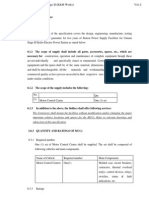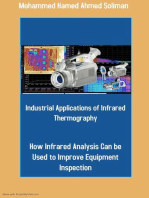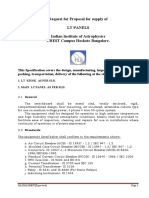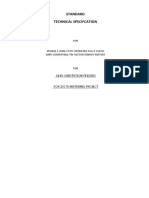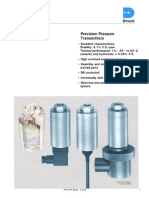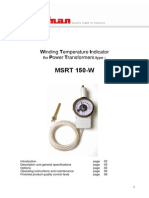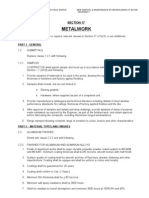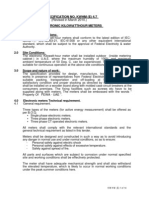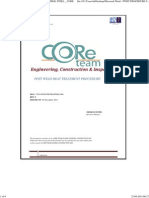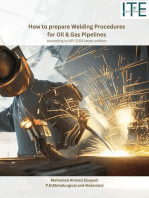Professional Documents
Culture Documents
Chapter-11 Static Whole Current Energy Meters
Chapter-11 Static Whole Current Energy Meters
Uploaded by
somashekarbrbescomOriginal Description:
Original Title
Copyright
Available Formats
Share this document
Did you find this document useful?
Is this content inappropriate?
Report this DocumentCopyright:
Available Formats
Chapter-11 Static Whole Current Energy Meters
Chapter-11 Static Whole Current Energy Meters
Uploaded by
somashekarbrbescomCopyright:
Available Formats
CHAPTER-11 STATIC WHOLE CURRENT ENERGY METERS
1. SCOPE This Specification covers the design, manufacture, testing before despatch, supply and delivery of Static whole current Electrical Energy Meters for use in urban/rural areas. 2. APPLICABLE STANDARDS Unless otherwise expressly modified and to the extent so modified from these specifications, the meters shall comply with the latest versions of IS 13779, IEC 1036 and CBI&P Technical Report No. 88. Further, meters from ISO certified manufacturers shall be preferred.
3. CLIMATIC CONDITIONS
i) Temperature : -10 C to 55 C(in shade) ii) Humidity : upto 95% RH non-condensing iii) Average annual rainfall : 150 cm.(if not specified otherwise) iv) Max. Wind Pressure : 150 kg/sq. m. v) Max. altitude above MSL : 1000 metres(if not specified otherwise) (To be modified as per site conditions) 4. TROPICAL TREATMENT : The meters shall be suitably designed and treated for normal life and satisfactory operation under the hot and hazardous tropical climate conditions and shall be dust and vermin proof. All the parts and surface which are subject to corrosion shall either be made of such material or shall be provided with such protective finish which provides suitable protection to them from any injurious effect of excessive humidity. 5. ELECTRICAL SPECIFICATIONS Class of Accuracy Supply Voltage Frequency Current Range (basic) Maximum Current Class 1, Class 2 240 V AC (Phase-neutral), 415 V (Phase Phase) or 230 V (Phase neutral), 400 V (Phase - Phase 50 Hz +/- 5% 2.5A, 5A,10A, 20A for Single Phase 10A, 20A, 30A, 50A for Three phase 600% of Ib upto 10A
o o
400% of Ib for 20A 200% of Ib for 30A and 50A Starting Current Power Factor Range Power Loss Resistance to surge voltage of 1.2/50 Microsec. Test Voltage at 50 Hz for 1 min. Clock Time accuracy 6. TEMPERATURE RISE As per IS 13779. 7. ANTI TAMPER FEATURES The meter shall have the following anti-tamper features: For Single Phase > 6kV peak As per IS 13779/IEC 1036/CBIP 88 2 kV rms +/- 5 ppm at 250 C As per IS 13779 0.5 lag Unity 0.8 lead As per IS 13779
i. ii.
The meter shall be capable of recording energy correctly even if input and output terminals are interchanged. Also the meter shall record correctly even if phase and neutral are interchanged. The meter shall register energy even when the load is not terminated back to the meter and instead current is drawn through a local earth under the conditions
a. when phase and neutral are connected correctly. b. when phase and neutral wires are interchanged at the input terminals. i. ii.
The registration must occur whether input phase/neutral wires are connected properly or they are interchanged at the input terminals. The meter shall be factory calibrated and shall be sealed suitably before despatch.
For Three Phase
i.
Meter shall log tampers of o o o PT missing Current circuit reversal Current circuit short/open
i. ii.
Shall record correctly in case of current reversal and shall record correctly irrespective of phase sequence. The meter shall be factory calibrated and shall be sealed suitably before despatch.
8. CONSTRUCTION The case, winding, terminal disconnecting device for the meter, voltage circuit, sealing arrangement, registers, terminal block, terminal cover and name plate etc. shall be in accordance with IS 13779 (latest version). The meter shall be compact and reliable in design, easy to transport and immune to vibration and shock involved in transportation and handling. The construction of the meter shall ensure consistent performance under all conditions specially during dust storm/heavy rains/very hot weather. The insulating material used in the meter should be non-hygroscopic, non-aging and of tested quality. The meter should be sealed in such a way that the internal parts of the meter are inaccessible. The meter should employ latest technology such as Hybrid Micro Circuit or Application Specific Integrating circuit (ASIC) to ensure reliable performance. The mounting of components on the PCB (Printed Circuit Board) shall preferably be SMT (Surface Mounted technology) type. The electronic components used in the meter shall be of high quality and there shall be no drift in the accuracy of the meter at least up to 10 years. The circuitry in the meter shall be compatible with 2x8 bit,16 bit(or better) processor (for three phase meters) and the meter shall be based on digital measuring and sampling technique. 9. DISPLAY OF MEASURED VALUES The meter shall have Electromagnetic counter impulse drum type or stepper motor register for single phase meters and the register shall have 5 digits +1 digit for decimal display. The register marking shall be indelible and easily readable and the digits should be of at least 4.5 mm X 2.5 mm. size. The material of drums shall be metallic or superior quality thermoplastic or high quality synthetic material POLYACETAL. The meter shall register energy within prescribed accuracy level even in the presence of harmonics. The ratio gear wheels shall be made of metal or special synthetic material to reduce friction, wear & tear and it should be resistant to magnetic field and tampering. The registering mechanism when subject to boiling 0 water test shall withstand a temperature of 100 C continuously for 5 minutes without any distortion or softening. OR The meter shall have Alpha-numeric LCD display with at least 6 full digits and preferably one decimal (optional) along with legend for single and three phase and the data shall not be lost in the event of power failure. The non-volatile memory shall have a storage life (without use) of at least 10 years. 10. METER CASE AND COVER The meter shall have a case which can be sealed in such a way that the internal parts of the meter are accessible only after breaking the seal. The cover shall not be easily removable from the base. The material of meter body (case and cover) shall be either (A) THERMOSETTING PLASTIC Self insulating non corroding black thermosetting material which would ensure maximum strength against distortion and also injury to working parts during normal use and rough handling during transportation. The material shall not soften/ melt on heating. OR (B) ENGINEERING PLASTIC The meter casing material should be glass reinforced, flame retardant, unbreakable engineering plastic
material to ensure high reliability, long trouble free life, safety against electric shock, spread of fire and effects of excessive temperature. The material should be corrosion resistant, inert to chemicals, oxidising agents, petro-chemical products, acids, salts, and ultraviolet radiation. The meter chamber shall be dust proof and moisture proof. The supplier should indicate hardness, melting temperature and tensile yield strength of the material and necessary test certificate of the same shall be furnished. The meter case and cover should be sturdy enough to prevent damage during transportation and installation. The engineering plastic housing may be provided with a key hole on the top for fixing which should not be accessible to the consumer after the terminal cover is sealed. The meter shall withstand external magnetic influence as per latest amendments of CBIP 88. The engineering plastic used shall conform to IS 11731 besides meeting the test requirement of heat deflection test as per ISO 75 and glow wire test as per the relevant Standard. OR (C) STEEL BODY The meter casing shall be made of sheet steel of at least 22 gauge(0.71 mm) thickness with 4 screws for fixing frame with lock and tempered spring washer. Synthetic rubber or any other non-hygroscopic material should be used for gasket and for fixing the meter cover over the body. The Bidder shall specify the thickness of sheet steel used for the construction of the meter cover, base and the material of the gasket in the guaranteed technical particulars. The window shall be dust proof made of toughened glass and be provided to permit clear view of register and indicator. Minimum clearance between window glass and name plate should be 8mm. Fixing arrangement should be such that the window glass can not be removed without breaking the sleeves of the window glass and shall be replaceable from inside only. 11. TERMINAL BLOCK AND COVER The terminals may be grouped in a terminal block having adequate insulating properties and mechanical strength. The terminal block should be made from best quality non-hygroscopic, flame retardant material (capable of passing the flammability tests given in IS 11731) with nickel plated brass or aluminium alloy for connecting terminals.. The terminal block is to be enclosed in a metallic housing of steel plate of sufficient thickness to cover its back and sides to provide enough strength for purpose of tightening of screws. The clamping screw should be provided inside the terminal cover and should have metallic sleeve moulded within the block to avoid damage during tightening of the screws. The terminals in the terminal block shall be of adequate length in order to have proper grip of conductor with the help of two screws. The screws shall have thread size not less than M4 and head having 4-6 mm. dia. The screws shall not have pointed ends at the end of threads. All terminals and connecting screws and washers should be of tinned / nickel plated brass material or aluminium alloy. The internal diameter of terminal hole should be minimum 5.5 mm. The holes in the insulating material shall be of sufficient size to accommodate the insulation of conductor also. The terminal cover shall be of sheet steel with minimum thickness 0.6 mm. or engineering plastic with minimum thickness 2.5 mm. and the terminal cover shall be of extended type completely covering the terminal block and fixing holes except for the provision of conductor entry at the bottom for incoming and outgoing leads. The terminal cover shall be so provided that it remains permanently connected with meter base. The supplier shall suitably design the cover so that it opens or closes like a hinged door and the ends of hinged pins shall be flattened so that it does not come out.
In order to facilitate testing of meters without opening the meter cover the voltage links shall also be provided preferably on front side above the terminal block so that the same is accessible from outside without opening the meter body cover or seal. Separate sealing arrangement should be available for these links. 12. METER FRAME As per Standards. 13. NAME PLATE AND MARKING: Every meter shall have a name plate clearly visible and indelible and distinctly marked in accordance with IS 13779(latest version). The following information should appear on an external plate attached to the meter cover:
i. ii. iii.
Manufacturers name or trade-mark and place of manufacture Designation of type Number of phases and number of wires for which the meter is suitable.
In addition to above, the following information shall be marked on a nameplate preferably placed within the meter:
i. ii. iii. iv. v. vi. vii. viii.
Serial number and year of manufacture Principal unit in which the meter records Reference voltage Basic current and rated maximum current Reference frequency in Hz Meter constant Class index Reference Temperature
14. INFLUENCE QUANTITIES : The meter shall work satisfactory with guaranteed accuracy as per limit of IS :13779 under presence of the following quantities :
i. ii. iii. iv. v. vi. vii.
External magnetic field Electromagnetic field Radio frequency interference Vibration Harmonic wave form Voltage fluctuation Electromagnetic high frequency field
15. LED INDICATIONS The following LED indications are mandatory:
i. ii.
Why indication Line load reversal indication (applicable for counter type meters)
iii.
Earth loading indication (applicable for counter type meters)
16. POWER CONSUMPTION BY METER As per IS 13779. 17. LIMITS OF ERRORS When the meter is under reference conditions, the percentage errors shall not exceed the limits as specified in IS 13779. 18. CURRENT & PRESSURE CIRCUITS As per IS 13779. 19. STARTING CURRENT The starting current of the meter shall be as per IS 13779 20. .FIXING ARRANGEMENT Every meter shall have three fixing holes one at the top and two at the bottom. The top hole shall be provided with a special clip at the back of the meter so that holding screw is not accessible to the consumer after the fixing of the meters. The lower fixing screws shall be provided under the sealed terminal cover. The requisite fixing screws shall be supplied with each meter. 21. SEALING ARRANGEMENT At least, two sealing screws shall be provided for proper fixing of the meter cover so that access to the working part shall not be possible without breaking the seal. Necessary provision may be kept for fixing the utility seal also. 22. OUTPUT DEVICE The meter shall have a test output device in the form of a pulse indicator accessible from the front and capable of being monitored by a suitable testing equipment. 23. COMMUNICATION CAPABILITY The meter shall have facility for data transfer with proper security via an optically isolated communication port using serial communication. Calibration of meter should not be possible through the meter reading instrument to avoid meter tampering through MRI. 24. UPGRADATION CAPABILITY (OPTIONAL) It should be possible to upgrade the meter at a later stage for remote metering facility.
25. RUNNING AT NO LOAD The meter shall comply with the requirements of IEC 1036/IS 13779. 26. D.C. IMMUNITY TEST The meter shall comply with the requirements of IEC 1036/IS 13779. 27.PACKING The meters shall be suitably packed for vertical/horizontal transport to withstand handling during transport. The Bidder shall be responsible for any damage during transit due to inadequate or improper packing. 28.ACCURACY The accuracy of meters shall not exceed the permissible limits of accuracy as per Standards for a period of at least 10 years from the date of supply. In case any drift is noticed which is beyond the permissible limits, the Bidder shall re-calibrate the meter for correct accuracy and if re-calibration is not possible, the meter shall be replaced by a new meter without any extra cost. 29. TESTS TYPE TESTS: Meters shall be fully type tested as per IS 13779 (latest version). The type test certificates shall be submitted along with the offer. Offer without Type Test Report shall be liable for rejection. The Type Test Certificate shall not be more than 5 years old. Test certificates of wider Ranges shall also be acceptable. The Acceptance and Routine Tests shall be carried out as per the latest version of IS 13779. In addition to above, the following tests shall also be performed: i) Running at low load for electromechanical registration mechanism. The energy registration mechanism of the meter shall be tested for satisfactory work at the point of maximum torque i.e. when all the drums are indicating digit 9. The test shall be carried out with 10% of the rated basic current. When so tested, the gearing mechanism should be integrated continuously without any stoppage or slippage. ii) Transportation Test(Acceptance Test) At least 50% of the sample meters shall be particularly tested for error at Imax, Ib at u.p.f. and 50% Imax, 10% Ib at 0.5 p.f. lag besides checking them for starting current and creep. The meters should be tested as aforesaid with the meter cover fully tightened and sealed. After recording the errors at the above test points, the meters should be placed in their normal packing and transported for a distance of at least 40 to 50 kms. in any transport vehicle such as a truck, jeep etc. on uneven rural roads, and then re-tested at the aforesaid test points after transportation. The variation in errors recorded before and after the transportation test at the said test points should not exceed 1% at higher loads and 1.5% at low loads. The mechanical strength of the meter shall be tested with spring hammer as per IEC : 68-2-63 (latest version).
TEST CERTIFICATES: The type test certificates shall be from Institutions approved by the purchaser/ Appendix G of CBIP Technical Report 88(Amended). 30. Guarantee: The meter shall have a design life of at least 10 years and be guaranteed for a period of at least five years against manufacturing/design defect. 31.QUALITY ASSURANCE PLAN: The design life of the meter shall be minimum 10 years and to prove the design life the firm shall have at least the following Quality Assurance Plan:
i. The factory shall be completely dust proof . ii. iii. iv. v.
The testing rooms shall be temperature and humidity controlled as per relevant Standards. The testing and calibrating equipment should be automatic and all test equipment shall have their valid calibration certificates. Power supplies used in testing equipment shall be distortion free with sinusoidal wave-forms and maintaining constant voltage current and frequency as per the relevant Standards. During the manufacturing of the meters the following checks shall be carried out.
a. Meter frame dimension tolerance shall be minimum. b. The pressure coil shall be made totally encapsulated and care shall be taken to avoid
ingress of dust and moisture inside the coil.
c. The assembly of parts shall be done with the help of jigs and fixtures so that human errors
are eliminated.
d. The meters shall be batch tested on automatic, computerised test bench and the results
shall be printed directly without any human errors.
e. The current coil shall be made with the help of jigs and fixtures. f. The potential coil shall be made with automatic computerised machine.
31. TESTING AND MANUFACTURING FACILITIES The Bidder shall have at least the following testing facilities to ensure accurate calibration:
i. ii. iii. iv. v. vi. vii. viii. ix. x.
Insulation resistance measurement Running at no load Starting current test Limits of error Range of adjustment Power loss in voltage and current circuits Repeatability of error Transportation test Low load run test Heating test
The Bidder shall give a detailed list of bought out items with name of the manufacturer and details about
quality control: NOTE 1 For Outdoor use, the meter shall be housed in a weather proof meter box made of thermosetting plastic/engineering plastic material with flame retardant properties. The meter box should be leak proof, shock proof, free from sharp edges and non-poisonous. The meter box should protect the meter from polluted environment, flame, rain water, dust etc. The meter box shall be capable of withstanding temperature of boiling water for 5 minutes continuously without distortion or softening. The boxes shall comply with the provisions of latest version of IS 5133 (Part II). The thickness of the box shall not be less than 3.0 mm. on the load bearing side i.e. back side of the box and the other sides, door and roof shall not be less than 2.0mm. The box shall have its roof tapering down to both sides for easy flow of rain water. The inside dimensions of the box shall be such that there is a minimum clearance of 75 mm. on all sides and a minimum clearance of 25 mm. at the front of the meter. Soft rubber gaskets shall be provided all around for protection against entry of dust and water. A viewing window made of break resistant transparent polycarbonate/engineering plastic/toughened glass shall be provided on the door for meter reading without inconvenience. The viewing window shall have adequate thickness and shall have a shade to protect the display from direct sunlight. There shall not be any ingress of moisture through this window into the box. The box shall have provision for minimum 2 no. seals to make it fully tamper proof.
You might also like
- Technical Specification - MCCDocument14 pagesTechnical Specification - MCCKunik Swaroop0% (1)
- Tangedco-Abt Meter Final Spec. (Both Bulk & WFHT SC)Document34 pagesTangedco-Abt Meter Final Spec. (Both Bulk & WFHT SC)Arun MuruganNo ratings yet
- LV Distribution Fuse Board (Feeder Pillar) Kahramaa SpecificationDocument29 pagesLV Distribution Fuse Board (Feeder Pillar) Kahramaa SpecificationRaison Mukkath100% (5)
- Industrial Applications of Infrared Thermography: How Infrared Analysis Can be Used to Improve Equipment InspectionFrom EverandIndustrial Applications of Infrared Thermography: How Infrared Analysis Can be Used to Improve Equipment InspectionRating: 4.5 out of 5 stars4.5/5 (3)
- Weld Like a Pro: Beginning to Advanced TechniquesFrom EverandWeld Like a Pro: Beginning to Advanced TechniquesRating: 4.5 out of 5 stars4.5/5 (6)
- Static CT/CVT Operated Trivector MeterDocument8 pagesStatic CT/CVT Operated Trivector MeterlrpatraNo ratings yet
- 3Ph 3wire CTPT Trivector Meter With PPMB For 11KV Boundary Metering 24.09.10 PDFDocument14 pages3Ph 3wire CTPT Trivector Meter With PPMB For 11KV Boundary Metering 24.09.10 PDFStephen BridgesNo ratings yet
- DLMS Spec For Bulk MetersDocument36 pagesDLMS Spec For Bulk MetersSuresh UmadiNo ratings yet
- Meter Specifications For Single Phase MeterDocument5 pagesMeter Specifications For Single Phase MeterRohan RustagiNo ratings yet
- 04 Electrical SpecificationDocument49 pages04 Electrical SpecificationVishal NarkhedeNo ratings yet
- RFP For LT PanelDocument13 pagesRFP For LT Panelsourendra prasad karan100% (2)
- Q EsvDocument4 pagesQ Esvknotship.comNo ratings yet
- Is 2551Document44 pagesIs 2551sankaractecheeeNo ratings yet
- Technical Specification of 11Kv 630A VCB Panel With 5 Nos 11Kv Lbs O/GDocument9 pagesTechnical Specification of 11Kv 630A VCB Panel With 5 Nos 11Kv Lbs O/GShayarrn KhatiwodaNo ratings yet
- LT AcdbDocument44 pagesLT Acdbanu2013No ratings yet
- SMB MSB Spec - Rev 3Document6 pagesSMB MSB Spec - Rev 3DardakNo ratings yet
- 3rd Party-NDT-CCS-Post Weld Heat Treatement Procedure For SAPID Approval PDFDocument11 pages3rd Party-NDT-CCS-Post Weld Heat Treatement Procedure For SAPID Approval PDFManoj Balla100% (1)
- 3 PH 3wire 11 KV FDR New - Dated 21.11.2011Document18 pages3 PH 3wire 11 KV FDR New - Dated 21.11.2011David AriasNo ratings yet
- Equipment Ring Main Unit Sno Spec Clause No. Query / Clarification Required Bidder's Response Resolution Technical Resolution Project: Name of ManufacturerDocument4 pagesEquipment Ring Main Unit Sno Spec Clause No. Query / Clarification Required Bidder's Response Resolution Technical Resolution Project: Name of Manufacturersyedabuthahir_mNo ratings yet
- Volume I I Technical Specification Part I I IDocument239 pagesVolume I I Technical Specification Part I I IMohit Patel100% (1)
- D7) 33 C&R Panel For Infra PlanDocument54 pagesD7) 33 C&R Panel For Infra PlanPunit AswalNo ratings yet
- Specification For Ducting of Ac PlantDocument7 pagesSpecification For Ducting of Ac PlantSubbarayan SaravanakumarNo ratings yet
- TC Anvira DesDocument3 pagesTC Anvira Desbenn savyasachiNo ratings yet
- PG - HT Solar Bidirectional MeterDocument24 pagesPG - HT Solar Bidirectional Meterdecorindo20020% (1)
- 11 KV PanelDocument93 pages11 KV PanelSunil Eprosys0% (1)
- DB Tech Specs - BDDocument5 pagesDB Tech Specs - BDDarshit VyasNo ratings yet
- 4.multi Panel CRPDocument59 pages4.multi Panel CRPraj_stuff006No ratings yet
- Document No PCPL-0532-4-407-04-06 Contol & Relay Panel Section - 4 PAGE: 1 of 6 ScopeDocument6 pagesDocument No PCPL-0532-4-407-04-06 Contol & Relay Panel Section - 4 PAGE: 1 of 6 ScopetceterexNo ratings yet
- Technical Spec For P-29-2012-13-DLMS & NON-DLMS 11KV BULK & LT BULK DLMS dt.18.02.2013Document59 pagesTechnical Spec For P-29-2012-13-DLMS & NON-DLMS 11KV BULK & LT BULK DLMS dt.18.02.2013Pawan Kumar RaiNo ratings yet
- 5.section-Lt Switchgear, Rev 05Document28 pages5.section-Lt Switchgear, Rev 05Uday Sankar YadavNo ratings yet
- Techinical Specification of Polymer 11 KV & 33 KV Pin InsulatorDocument14 pagesTechinical Specification of Polymer 11 KV & 33 KV Pin InsulatordamlanNo ratings yet
- Ptx-600 Pressure TransducerDocument4 pagesPtx-600 Pressure Transducerhvdb72No ratings yet
- Insulation SeminarDocument55 pagesInsulation SeminarDelta akathehuskyNo ratings yet
- GS 50PG 4PDDocument8 pagesGS 50PG 4PDSalvador Loyola TreviñoNo ratings yet
- 11kv and 33KVDocument43 pages11kv and 33KVArun KumarNo ratings yet
- 6.8 Construction: 6.8.1 Rectifiers and ThyristorsDocument1 page6.8 Construction: 6.8.1 Rectifiers and ThyristorsSatyasrinivas PulavarthiNo ratings yet
- CCTV SpecDocument130 pagesCCTV SpecJeffrey TeoNo ratings yet
- Cbip 88Document14 pagesCbip 88Sai Kanth100% (1)
- Engineering Specification For MV SwitchgearDocument21 pagesEngineering Specification For MV SwitchgearSundaresan SabanayagamNo ratings yet
- Technicall Specification of 630 KVA, 11-0.415 KV Dry Type Outdoor Transformers.......... Dated. 31.08.2015Document25 pagesTechnicall Specification of 630 KVA, 11-0.415 KV Dry Type Outdoor Transformers.......... Dated. 31.08.2015spidervinoNo ratings yet
- CTOperated TOD Meters Specifications 04 03 08 PDFDocument24 pagesCTOperated TOD Meters Specifications 04 03 08 PDFRitesh JaiswalNo ratings yet
- Specification For Power Control & Earthing Cables PDFDocument17 pagesSpecification For Power Control & Earthing Cables PDFg1kumar04100% (1)
- Specification of LT Capcitor PannelDocument12 pagesSpecification of LT Capcitor PannelPrashant TrivediNo ratings yet
- 100 - 5A LT CT Operated TOD Meters With RS 232 Port 130608Document24 pages100 - 5A LT CT Operated TOD Meters With RS 232 Port 130608Ritesh JaiswalNo ratings yet
- Winding Temperature IndicatorDocument9 pagesWinding Temperature IndicatorTruong Van Quang100% (2)
- 39HQ Guide Specification EN 25022022Document14 pages39HQ Guide Specification EN 25022022Jerome IlaoNo ratings yet
- Spe 60.44.04-001Document3 pagesSpe 60.44.04-001Silo MiyanNo ratings yet
- PWHT ProcedureDocument8 pagesPWHT ProcedureTuesou MachereNo ratings yet
- E21-Control & Relay Panel - 17!05!2013Document74 pagesE21-Control & Relay Panel - 17!05!2013Shatrughna SamalNo ratings yet
- 17 Metal WorkDocument10 pages17 Metal WorkUlfathbary ABNo ratings yet
- CSC 115R 1Document15 pagesCSC 115R 1walid kawsarNo ratings yet
- Meters & Metering Cabinet & MCCBDocument30 pagesMeters & Metering Cabinet & MCCBnatsclimbersNo ratings yet
- Abt Meter SpecificationsDocument11 pagesAbt Meter SpecificationsriteshnaikNo ratings yet
- PWHT Procedure For Petrol Steel - CoreDocument9 pagesPWHT Procedure For Petrol Steel - CoreSuleyman HaliciogluNo ratings yet
- 220 KV GISDocument35 pages220 KV GISBilal Ahmad67% (3)
- Specification NGRDocument7 pagesSpecification NGRPrasenjit MaityNo ratings yet
- Annexure-A Technical Specifications For Heat Shrinkable Cable Terminations and Joints For 6.6kV, XLPE CablesDocument4 pagesAnnexure-A Technical Specifications For Heat Shrinkable Cable Terminations and Joints For 6.6kV, XLPE CablesHossam AlzubairyNo ratings yet
- How to prepare Welding Procedures for Oil & Gas PipelinesFrom EverandHow to prepare Welding Procedures for Oil & Gas PipelinesRating: 5 out of 5 stars5/5 (1)
- On-Chip Electro-Static Discharge (ESD) Protection for Radio-Frequency Integrated CircuitsFrom EverandOn-Chip Electro-Static Discharge (ESD) Protection for Radio-Frequency Integrated CircuitsNo ratings yet
